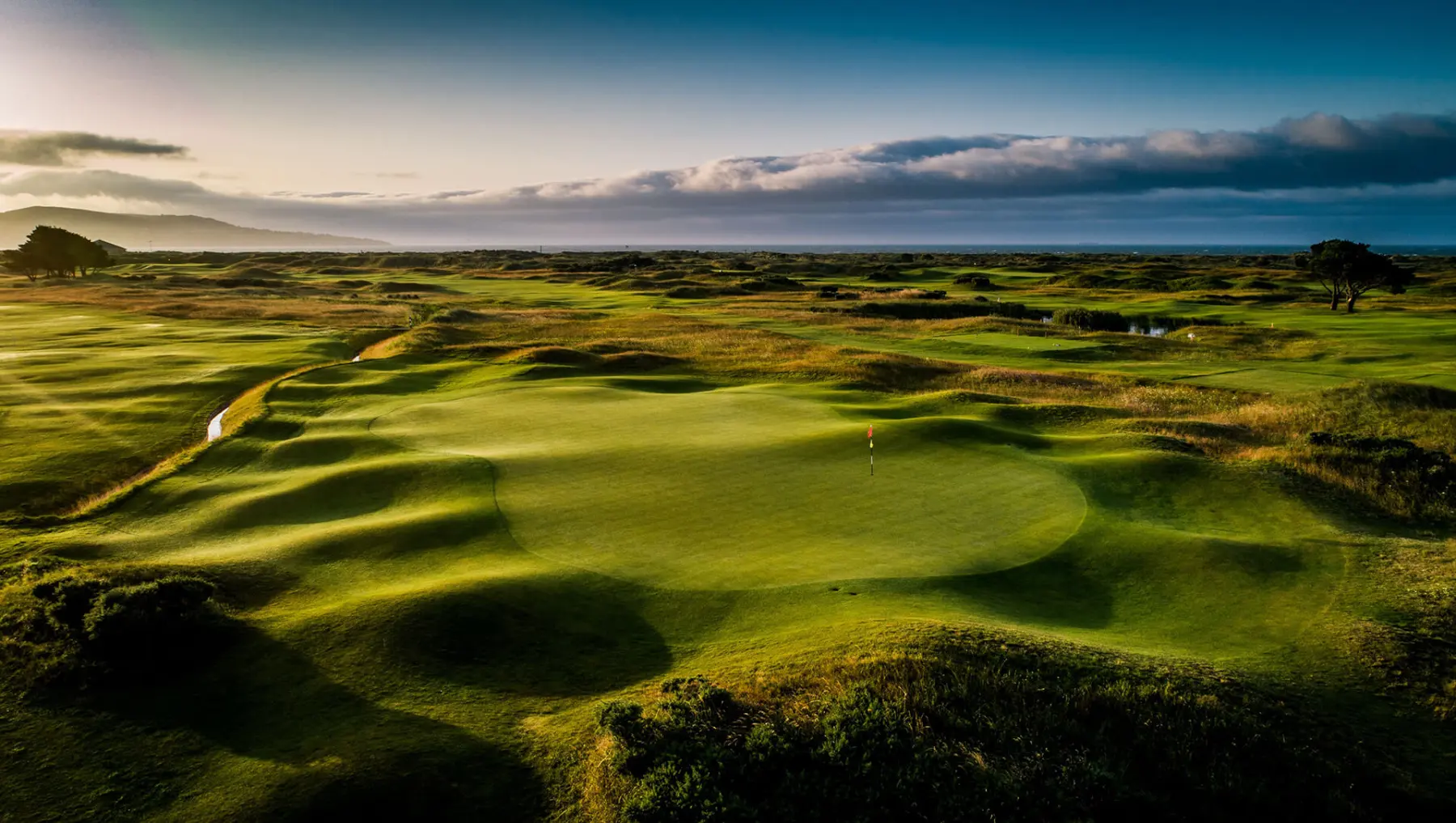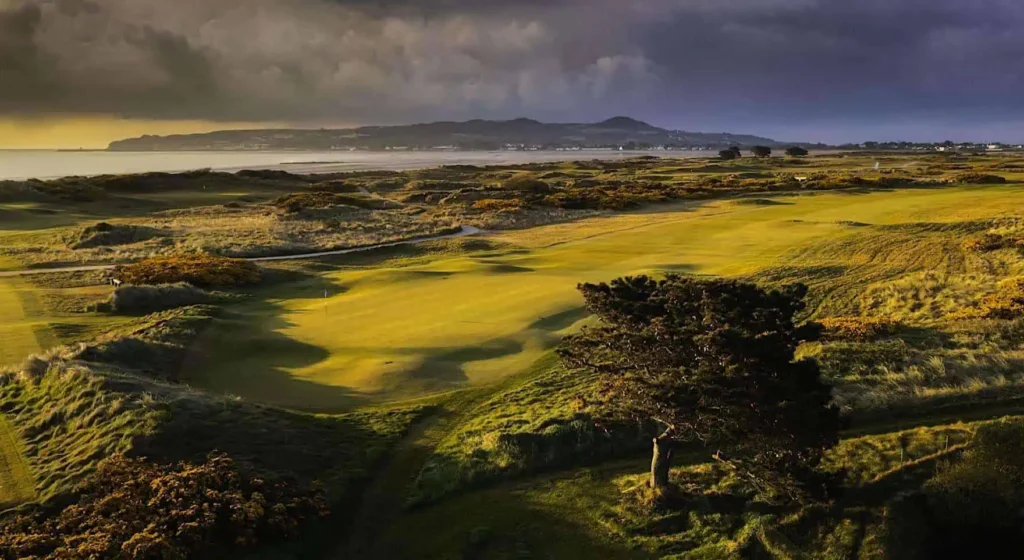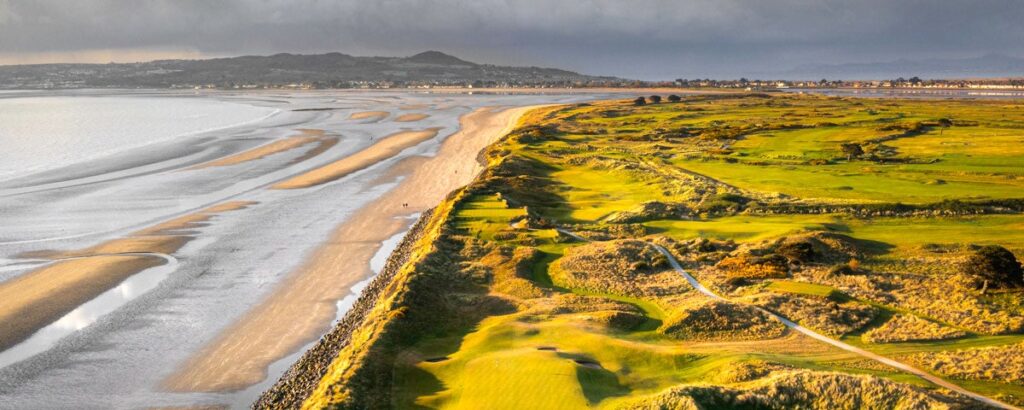
Royal Dublin
Anyone who enjoys the game of golf owes it to themselves to have a trip to Ireland on their bucket list. Some of the courses here occupy homesteads demarcated by gray-rock walls with ancient castles in the near distance. Others are within grand resorts (the Irish love their holidays) and are popular because virtually everyone in this nation has some knowledge of golf and most regularly play.
Yes, the famed links courses (The European Club, Ballybunion, Lahinch, Old Head, et al.) are musts to tackle on any journey to Eire and grab a lot of the attention for visitors to this golf-loving country. But those courses are in remote areas and take some determination and real planning to travel to and play.
How about making it easy on yourself? A flight into the Irish capital of Dublin (the nation’s largest city) puts golfers in the center of everything and in the perfect spot for scores of renowned and challenging courses — both on the coast and a half-hour’s drive inland.
For this snapshot of courses in Dublin, we focused on a quartet of links-style tracks just to the north of the City Centre — Royal Dublin Golf Club and St. Anne’s Golf Club (both on Bull Island in Dublin Bay), the finer-than-fine Old Course at Portmarnock Golf Club just a bit to the north and The Island Golf Club on the north bank of the Broadmeadow Estuary, a course that’s considered “the best in Ireland you have never heard of.”

Postmarnock
Bull Island home to pair of wonderful options
None other than Captain William Bligh of “Mutiny on the Bounty” infamy proposed in the early 1800s the construction of a seawall two miles out from the shore to help solve a long-standing problem of providing a safe, straight and deep approach into Dublin at the mouth of the River Liffey.
Thus was born a sand bank now known as Bull Island that runs parallel to the districts of Clontarf (including Dollymount), Raheny and Kilbarrack, and facing Sutton along the coast of the Irish Sea.
The accumulated silt and the dunes created over the dredging work and the past 217 years make for excellent terrain for the pair of links-style golf courses on Bull Island Royal Dublin Golf Club (at the south end) and St. Anne’s Golf Club (to the north, just across a one-lane road from Royal Dublin).
Royal Dublin Golf Club was founded in 1885 and received its “royal” designation in 1891, two years after it moved to its current 160-acre home on Bull Island. Royal Dublin is Ireland’s second-oldest golf club.
During World War I, the course was taken over by the military and used as a rifle and artillery range; there are still, in fact, some visible foxholes and artillery works. After the war, the links was redesigned by famed golf architect H.S. (Harry) Colt in 1920. Martin Hawtree renovated the course for the modern game in 2006 and it now stretches to 7,269 yards from its back set of three tees.
Royal Dublin offers a combination of challenge and playability, all enhanced by an out-and-back routing. Its exposed island location is relatively flat, making the constant wind off the Irish Sea a particularly important playing factor. The challenge at Royal Dublin is further complicated by narrow fairways and extensive stretches of out of bounds.
Generally, the front nine plays downwind, making the home half (which is 550 yards longer than the front) particularly difficult. Royal Dublin Golf Club’s real tests are its bunkers, a Colt specialty. The steep-faced greenside bunkers are set perfectly, almost deviously so. Sometimes approaches that land on the putting surfaces won’t hold as Hawtree’s restoration included aggressive contouring with roll-offs toward nearby traps.
The fairway bunkers are only slightly kinder. With any Colt design, the purpose is to make players think and execute shots, while adding a few more strokes to the scorecards of those who don’t. Adding even more spice here is a meandering stream that enters play more than once, high and dense rough that must be avoided at any cost, and a smattering of blind drives.
Hawtree’s work added teeth to several holes, the toughest of which is the 483-yard 18th, which turns 90 degrees 300 yards off the tee around an environmentally sensitive area with a deep burn in between it and the green.
Nothing about Royal Dublin is easy or to be taken for granted. The course asks for solid ball-striking and good course management. This is an exceptionally demanding examination of links golf that will keep any player on their toes from the opening drive through the last hole.
Royal Dublin’s sister course at St. Anne’s Golf Club is less severe but still a solid test. Founded as a nine-hole track in 1921, St. Anne’s Golf Club was originally fashioned by Irish architect Eddie Connaughton. Nine more holes were designed by Eddie Hackett (whose most famous work is Waterville in southwest Ireland) and added in the late 1980s.
Though less well-known than Royal Dublin, St. Anne’s is first-rate as a traditional links, stretching to 6,717 yards from its back set of four tees and is a par-71 that includes just three par-5s. There is not a pushover hole, and wind conditions play a major role in how the course is attacked. Its unique setting offers splendid views of Howth Head to the northeast and across Dublin Bay to the Wicklow Mountains to the southwest.
In 2003, an extensive redevelopment of the course was completed, with a part of the reworking including a lengthening and further definition to the back nine. There were also five new greens and eight new tees fashioned, all of which were sodded with turf from old Croke Park, the Dublin stadium that is the principal arena and headquarters of the Gaelic Athletic Association.
The beauty of St. Anne’s lies in its naturalness. Downwind holes require well-judged running shots on fast-running fairways and greens.
The final three holes are memorable and typify the natural links feel of the course. The 370-yard 16th is a par-4 and superb driving hole where trouble threatens along the right and bunkers lurk left. Its large green is separated in the middle by a hump.
The 17th is a fine 186-yard, par-3 where bunkers guard the entrance to the semi-blind green.
On the tee of the 430-yard closer, the green is tucked behind a hillock and slightly to the left. A line of low dunes provides the direction of the fairway, which contains a series of low hummocks that will kick the ball either left or right. The right side of the fairway gives the most direct path to the green but it’s tighter, and balls hit left will require negotiation of the hill guarding the putting surface.
St. Anne’s is a compact links with many holes running parallel between low-lying sand hills, which add character. It’s a blast to play and make for a splendid companion option to Royal Dublin.

St. Anne’s Golf Club
Everything great about Irish golf can be found at Portmarnock
Located just north of Dublin in the hamlet of Portmarnock about 15 minutes from City Centre, Portmarnock Golf Club and its grounds occupy some 500 acres of a small peninsula wedged between the Irish Sea and a tidal inlet north of Dublin Bay.
There are 27 holes at this sublime facility — the Old Course, whose red and blue nines were designed by the club’s founder, William Pickeman, and date back to 1894, and a third nine (yellow) fashioned by Fred Hawtree in 1971, that has characteristics similar to the original course.
The isthmus was once owned by whiskey distiller John Jameson and his family (they had a home and an unrelated private nine-hole course on the property’s north side) and originally consisted of just nine holes, with another nine added two years after the club was founded.
The Old Course’s par-72 layout is 7,466 yards from its back set of three tees. But its appeal is not length – it’s the course’s variety that makes it so memorable. Surrounded by water on three sides and laid out in a serpentine manner which eventually leads back to the clubhouse, Portmarnock has no successive holes running in the same direction.
When the wind is up, all bets are off trying to tame this beast. The routing winds between dunes and involves a handful of elevated tees, some blind approaches and twisting doglegs.
The current layout follows the original course, although it’s been lengthened considerably over the decades. The only significant change was the insertion in 1927 of a now-famous par 3, the 204-yard 15th, which shifted the original 15th to a hole ahead.
Though the narrow, dimpled fairways curl between thick fescues and are demarcated by deep pot bunkers, the landing areas are generally in full view from the tee and mostly flat. The bounces are usually predictable and the hazards stern, but they are not impossible to recover from unless you’re deep in the treacherous and gnarly fescue and marram grasses bordering the holes.
Holes 15-17 at Portmarnock Golf Club are considered among the finest in the Emerald Isle. The 15th lies directly along the shore, and from its elevated tee the proper shot must arc over thick rough to a low-lying green surrounded by three pot bunkers and flanked left by a deep recess. Immediately right of the green are a thick hedge and marram grass.
At the start of the 577-yard par 5 16th, the fairway looks like a mowed path in a tall-grass field. The landing area is sloped, but never for long in the same direction, and is later bisected by a three-foot-high ridge. The putting surface slopes severely from back to front and is well-bunkered.
The brutal 472-yard 17th is a straight par-4 that usually plays into a prevailing wind. The approach, attacked with a hybrid or fairway metal, is to a putting surface partially obscured by a right-hand bunker and snaggy grass.
Like all true links Portmarnock was designed by Mother Nature, though what makes it a classic is how Pickeman crafted — and later architects refined — cleverly consistent holes across the terrain’s low-lying features.
Portmarnock Golf Club offers splendid views of Ireland’s Eye (a small island near Dublin Bay) and, when looking inland, of the country’s capital city. But don’t get distracted – Portmarnock Golf Club demands your full attention on every shot. It doesn’t overwhelm with pretty vistas, huge dunes or massive pot bunkers. Instead, it boasts one demanding hole after another, each with a different strategy because of the ever-changing winds and varied directions of play.

Postmarnock
The Island Golf Club revels in its lack of notoriety
There’s nothing wrong with understatement when it comes to self-promotion and hyperbole. A fine example of such is shown by the Island Golf Club in Ireland, a course that’s only underrated and less-well-known than other great Emerald Isle tracks because it wants to be.
Located in Donabate, just north across the water from the busy suburb of Malahide, The Island Golf Club might be the best “pure” links course on Ireland’s east coast. Even though the hustle and bustle of Dublin is on the near shore (and the club a mere 15 minutes from the Dublin airport), the course provides a secluded experience because of the way the dunes buffer the outside world.
Bordered by the Broadmeadow Estuary, Donabate Beach and the Irish Sea, the Island Golf Club’s huge, natural dunes – some of the highest in Ireland – are its calling cards.
The venue is also one of the most historic courses in the country. In the 1880s, four wealthy bachelors rowed across the inlet between Malahide and the island to inspect the territory and found the site to be perfect for golf and their solitary pursuits. Eventually a group of 10 locals banded together to lease the land, and the club was founded in 1890.
From there, The Island Golf Club simply evolved. The property is akin to the rugged links of southwest Ireland; some have called it “the Lahinch of the east coast.” Nobody knows who designed the original golf course, but renovations were made by Fred Hawtree in the early 1970s, implemented and augmented by Eddie Hackett, in advance of the club’s 100th anniversary in 1990.
The club remained strictly private until after the Second World War, when a lack of funds prompted the move to selling memberships. Through the years, 10 new holes have been adapted into the original layout and other changes helped rid the course of its many awkward, blind shots. Recently, Martin Hawtree (a descendant of Fred) has been working to refine the course, a job that continues today.
The golf architecture firm of Mackenzie & Ebert reworked the bunkers on five holes (the fifth, sixth, 10th, 15th and 17th) over a couple of recent winters, changing the revetted style to a larger, rougher-edged shape. An old additional par 3 hole was then introduced as the new fourth hole with a raised tee in 2019 and new tees for the new fifth (formerly the fourth) were then bought into play and the green for that hole moved closer to the clubhouse.
The back nine at The Island Golf Club is considered by many as the strength of the course and is much more difficult and more scenic as many holes run alongside the surrounding water. Nos. 12-15, which circuit the edge of the peninsula, vie for the best four-hole set on the Emerald Isle.
The course’s signature hole is the 13th, a 220-yard par-3 on which golfers can use the bailout option just short and left of the green, but the more daring will take on the beach and hope for the best.
The fairway of the arrow-straight, 369-yard par-4 14th where the old clubhouse once stood, is a mere 12 yards wide, making it possibly the narrowest in all of golf. It’s lined by dunes left and out-of-bounds right. The 563-yard, par-5 15th is like a rollercoaster that twists and tumbles its way towards a putting surface backed by a stand of massive sand hills.
The finishing hole — a 460-yard par-4 — demands a straight drive into or through the valley, where it opens up en route to a 42-yard-deep green set on rising ground.
The Island Golf Club doesn’t carry the high-profile credentials of Ireland’s more commercially oriented courses. However, it can tantalize, tempt, satisfy and infuriate golfers with its eccentricities. It remains a wonderfully idiosyncratic place and provides one of the most stunning, natural and peaceful golf outings in Ireland, ultimately making it a world-class links that must be played and enjoyed.

Island Golf Club

